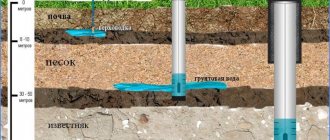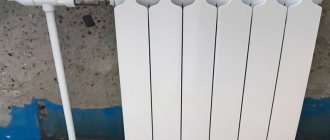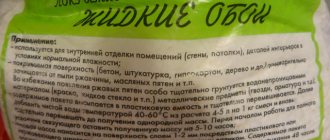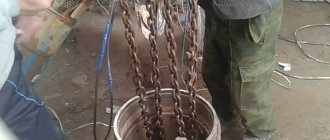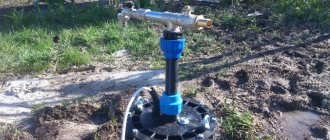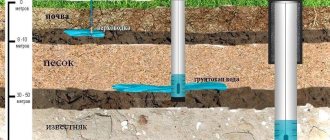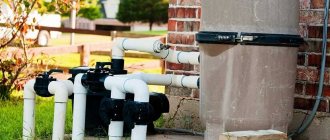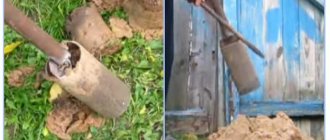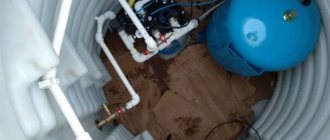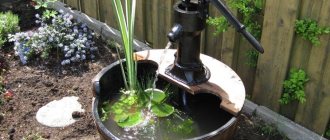Extracting drinking liquid from an autonomous well, located at a remote distance from the central highway, is the primary task of land owners before starting construction work on building a house. Of course, drilling a hole is not something everyone can afford, but the investment will pay you back within a few years. As a result, you will receive high-quality clean water with optimal mineralization. Many citizens get scared when they initially see the arrival of a dirty stream with various suspensions. We assure you that this is how it should be. There is no reason to worry, since the problem is solved by pumping the well after drilling and casing in a short time. Depending on the depth of the trunk and the properties of the soil, the process can last from 5-6 hours to several weeks.
Why is this event required?
The structure definitely needs cleaning, since the brown-colored liquid released to the surface is absolutely unsuitable for domestic and agricultural needs. Imagine how moisture, over centuries, formed its path deep underground, making its way between various layers of rocks, thereby being purified naturally and enriched with various minerals (this depends on the geographical latitude of our country). And here, overnight, the movement of the riverbed changed; accordingly, the liquid rushes to the surface and at the same time swirls the soluble and insoluble inclusions and organic matter found in its whirlpool. In addition, silt deposits and large volumes of sand can accumulate at the bottom of the column in the source. The only way out of this situation is to pump out the dirty substance.
Where does the oil in tap water come from?
“Greasy” tap water usually appears where the water supply system to residents’ taps and the heating system is not separated. Additives can be added to the composition of water for heating systems, which reduce the formation of air blockages, reduce the formation of rust, etc. They often have fatty components.
Also, “oily” water from the water supply can appear when accidents occur at pipelines and pumping stations. In this case, you should call the hotline of the utility company that serves your home.
Both problems mentioned above can be eliminated by flushing the water supply system.
How long does it take to pump a well after drilling?
Unfortunately, drilling companies do not provide cleaning services; they only pump out the turbidity that is formed as a result of the passage. You will have to take the final operation into your own hands. Let’s immediately say that the process can be fleeting or protracted, since the result depends on many factors:
- Depth of the well to the aquifer.
- The chemical composition of the layers through which the path was laid.
- Pumping equipment power.
- Drillers' professionalism.
No one will give you an exact date for finishing the work; this will happen when the water starts flowing continuously or at intervals of 30 minutes. The event may take days or weeks. But under no circumstances should you stop, as your efforts will not be crowned with success and the source will instantly be covered in dirt. In practice, there are often cases when cleaning an artesian well took months. Subsequent examination revealed the following violations:
- The submersible pump is installed incorrectly (too high from the bottom).
- The equipment captures silt and sand. Low mounting can cause the device to burn out.
- Pumping occurs in close proximity to the mouth of the source (that is, the liquid again enters the shaft).
The main reasons for clogged water wells
There are several reasons why wells become contaminated; this is either simple dirt getting in from the outside, or a consequence of improper installation of well equipment. The most common cause of well clogging is sanding or silting. Before starting work on cleaning a well, it is necessary to establish the source of contamination, as this determines the methods by which cleaning will be carried out.
Sanding
Sanding occurs after sand particles get into the casing; properly designed and installed equipment helps to avoid this.
Sanding occurs for the following reasons:
- The head or caisson is not airtight enough.
- The filter was selected incorrectly.
- Poor quality welding of elements.
It is not possible to eliminate leaks already inside the well. Fine sand that constantly penetrates through the filter is easily removed. The situation is different when large sand particles get into the filter; they are not washed out and settle in the well. To avoid this, you need to select high-quality filters for the well and correctly install the casing elements.
Siltation
The accumulation of small particles on the filter can cause the filter cells to clog. This makes it much more difficult for water to enter the excavation column. As a result of this, the process of “siltation” begins. This can lead to complete loss of fluid supply. This process occurs slowly inside the source and can last for decades.
At the same time, errors in the design of the structure and dirt that gets into it from the outside can lead to silting even in a well that is regularly used. Otherwise, when the well is not operated on a regular basis, the processes described above can be accelerated many times over, and the water can completely disappear after 5-6 years. To combat this, it is necessary to carry out timely treatment of the well and clean it of stagnant sludge.
Stages of well build-up after drilling
If you have entered into an agreement with a professional source development company, then include a clause in the agreement regarding the provision of cleanup services. This way you will save a lot of time and money. If refused, you will have to perform the operation yourself.
Getting ready for the process
Citizens of Russia who do not have the financial ability to pay for the service of a firefighting or sewage disposal truck are faced with a pressing question: where to get a large container for transferring dirty substances.
There is an effective method that has been proven over the years - digging a special pond-sump. If you turn on the pump every hour (except at night), and let it run for two/three minutes, the sump will not overflow. But when the flow begins to flow continuously, then you can supply water to the house.
Choosing equipment
1.5 m3/h For process water
1.5 m3/h For process water
MBFT-75 Membrane for 75GPD
Put aside the purchased submersible device intended for pumping drinking liquid until better times. It is not suitable for dirty work, since not all models can withstand excessive load. Large inclusions will instantly clog it, and you will end up with a non-repairable item. For pumping, it is better to purchase a pump with a centrifugal operating principle. Get advice on your choice from competent companies, such as Voda Otechestva. Experts will tell you why you should not buy snail-type submersible devices or vibration options, and will select the most suitable inexpensive unit for your purpose. Retail chains offer special products designed for moving dirty suspensions. They are called “fecal and drainage”. These gadgets are perfect for pumping out substances that have many foreign inclusions. But it is worth paying attention to the maximum possible lifting column. Since such products are usually not able to create sufficient pressure.
Pumping the well
We proceed to the important operation for which the preparatory work was carried out:
- Typically, the pump is equipped with a long cable. Check whether this is enough to complete your task. Otherwise, it is necessary to eliminate the problem by extension.
- The drainage device lowers to the level of suspended matter with the possibility of slow immersion. This ensures correct operation without overload.
- If possible, it is necessary to position the object in the center of the well so that it does not touch the walls. This will allow optimal removal of sediment.
- During the process, you need to monitor productivity; if it decreases, you will have to lift and rinse the device.
- All these actions are performed until a clean flow is obtained.
When things aren't so bad
The content of some impurities is not as dangerous as it might seem. For example, silicon in well water may be beneficial. Naturally, if the level of its content does not go off scale.
Please note that silicon is included in various preparations:
- cosmetic;
- medicinal.
This is due to its truly useful, positive properties established by scientists:
- the ability to strengthen the immune system;
- promote rapid growth of nails and hair;
- restore skin;
- have a healing effect on wounds and damage.
In addition, silicon is important because if it is not in the body, then the absorption of other minerals will not occur, including:
- zinc;
- calcium and more than sixty items.
Many people are interested in the question, why does well water turn green? In this case, there is also no need to panic. If the appearance of greenery occurs a few days after you have collected water in a certain container, then this indicates the proliferation of biological components that are included in the liquid.
Of course, you can no longer drink green water, but you can use the liquid for drinking immediately after extracting it from the well.
How to pump out sand from a well if flushing is delayed
During drilling, it is possible to enter complex formations. These are most likely large sand layers, which are unstable by definition. If you are trying to ensure a continuous water supply, but the level is constantly decreasing, you may want to consider installing a cartridge that prevents large particles from entering the barrel. The problem of such layers can be solved by radical strengthening of the walls or a filter in the drainage area. Another way to eliminate this is to deepen the well to stable rocks with mandatory casing.
What to do if the water has a white sediment after boiling?
The preference for a specific softening water treatment technology should be given based on whether you want to solve this problem locally or on a large scale:
- If you only need soft drinking water, the filter jug we are all familiar with is quite sufficient. True, your home appliances will still work with water of increased hardness.
- Once you decide to take care of the long-term performance of household appliances, a good solution would be to buy special tablets or powders that soften water. This is an excellent option for dishwashers and washing machines, which, however, is completely unsuitable for treating drinking water if a white precipitate forms when the water is boiled.
- But let’s say you still approach the issue globally. Then we recommend that you think about installing reverse osmosis filters. They will soften all the water that comes to you from the taps, and you will not have to worry about your health or the condition of your appliances.
Why can a well silt up?
Sooner or later, any hole collects solid particles and closes. Approximately the same processes occur in any trunk. Groundwater flows only in the direction of pumping; everything that it brings with it precipitates to the bottom of the source. If the surrounding rock is prone to washing away, then you will have to deal with this problem constantly. Only the installation of filter systems can cope with this for a certain time. Limestones, sandstones and a fairly large number of rocks provide stable access to liquid without impurities.
Another important problem can be considered the rare use of the source. The entire surface of the earth tends to be a perfect sphere and over time, gravitational forces will tighten the mine if you do not make any efforts to prevent this.
How to choose the right cleaning option?
It can be difficult even for a specialist to determine exactly why a well’s production rate has dropped. As a rule, pollution is complex. If the pump “drives” sand with water, this does not mean that the soil is not silted.
When cleaning a well with your own hands, you should be patient. You may have to apply several methods in succession and try hard before obtaining a satisfactory result.
We recommend starting with the simplest: pumping with a vibration pump. If pumping does not help, move on to flushing. We start with washing if the source has almost dried up. If there is a lot of sand at the bottom, a bailer will help to scoop out sand.
But it cannot be used for plastic casings, only for steel ones. For polymer barrels we use only bubbling. If there is neither sand nor water in the steel casing, we move on to water hammer technology.
This is, of course, if the aquifer itself has not dried up. Renting a washing machine, of course, costs a pretty penny, but the cleaning efficiency is noticeably higher than when using homemade methods.
Leveling methods
A freshly drilled source has a wall structure that is prone to movement under the slightest influence. Groundwater displaces small solid inclusions in the direction of minimum resistance. Until a stable frame is formed, tiny particles of nearby rocks will flow into the well. Therefore, after the creation of the facility, it is necessary to carry out a set of measures to ensure the consumption of sufficiently clean water. There are different options for solving this problem.
SF-mix Clack up to 0.8 m3/h
SF-mix Runxin up to 0.8 m3/h
SF-mix manual up to 0.8 m3/h
How to properly pump a well after drilling with your own hands: vibration pump
The simplest and most frequently used method is to carry out such operations using standard dacha equipment. Of course, this is not the most effective method and after completing the process you will probably have to throw away the device. But this device has its advantages. Vibration provokes an acceleration of the washout of unstable nearby layers. The pump itself is capable of processing sufficiently contaminated liquids without a sharp loss of performance. Perhaps the main limitation is the height limit of the pillar. Not bad for cleaning domestic wells no deeper than 10-15 meters.
Bleeding with two electric pumps
In the professional field, loosening of lower deposits using liquid pressure is widespread. To do this, the water pumped out by the first pump is sent to the sediment to remove solid deposits, and after that the same substance is injected under sufficiently high pressure into the siltation point. This operation ensures effective mixing of the lower layers and radically facilitates the suction of suspended matter.
For domestic use, we can recommend the cyclic use of a simple home pump. In this case, it is necessary to have a large container to collect pumping products. At intervals that allow for sedimentation, water is directed deep into the trunk and mixes the lower horizons. After this, it remains to quickly pump out the resulting suspension.
The pressure and direction of the jet when breaking rocks at the base of the well is considered a fairly important factor. Therefore, preliminary washing is carried out using special nozzles that ensure maximum capture in space of the spherical surface of the liquid intake point.
Moisture return method
This is a fairly effective method, but requires serious equipment. The idea is that source purification is accomplished by pumping excess fluid under very good pressure through the main barrel to flush unnecessary contaminants to the surface. In this case, all the pulp exits into the space between the rock and the casing. The sinuses are partially cemented and the cavities are filled, which has a beneficial effect on preventing the entry of atmospheric precipitation into the source. But this cannot be the final action to ensure the purity of the resource. In any case, you will have to use classic leaching, since there is no natural leaching of easily moving particles by groundwater. And during use, as is the norm, they will definitely reach the suction point. This problem can be eliminated by repeatedly using the technique at intervals of an hour or three or alternating with the vibration method.
Compressor technology
This option may be an alternative to all of the above methods. If the well is sufficiently abundant and the column is normally high, then it is quite possible to lift the liquid with all the suspensions outward by pumping in a decent amount of air. This does not work with wells with a diameter of 20 centimeters, but with holes of 5-10 cm it is quite possible to carry out the procedure. In this case, the equipment does not fail, since it does not come into contact with the abrasive. It is worth noting that an ordinary household compressor is not suitable for the process; the flow rate must be at the level of a serious industrial unit.
Causes of pollution
The depth of groundwater is shallow, so the source is not always clean. There are dissolved or dry impurities in the well. Microorganisms live and develop in the upper layers, the decomposition of which causes an unpleasant taste or aroma of the liquid.
Causes of infection Source kolodetsoved.ru
Well water is susceptible to contamination more often than moisture from a centralized main. There are 3 types of reasons:
- Natural phenomena. The culprits are floods or changes in underground sources due to heat and exposure to sunlight. Transformations occur when accidentally exposed to the corpses of animals, birds or fallen leaves.
- Human factor. The close location of a drainage pit, a cattle pen, and the active use of fertilizers provoke contamination of the water in the well. Chemical or agricultural runoff may enter the source.
- Structural destruction. Due to improper installation and active use, the seams become depressurized and the well elements break.
Often wells are installed on quicksand. Due to the high content of impurities in the water, the owner will have to control the concentration and eliminate the signs. The soil around the structure is subsiding and the seams may become depressurized, leading to moisture contamination.
Well contamination Source sovet-ingenera.com
Causes of dirt in water Source sovet-ingenera.com
Which submersible pump will be most ideal for the task?
From what we have written above, it becomes absolutely clear that creating your own water supply point is not a cheap undertaking. It is necessary to invest considerable funds for geological exploration of the area, drilling, casing the structure, carrying out communications to the house (digging a trench, laying pipes and connecting to entry/exit zones). You will also have to spend money on the purchase of two pumps: for domestic use on an ongoing basis and for temporary dirty work. The latter option will have to be thrown out after the end of use, although experts say that rehabilitation is possible. In any case, it is unlikely that you will be able to understand the intricacies of the nuance on your own. To avoid mistakes and excessive spending of money, we recommend that you seek help from organizations that have been working in this area for a long time and have many positive reviews from clients. For example, managers will give you comprehensive answers to all your questions and help you choose a model from a wide range of domestic and foreign devices presented on the Russian market.
AMETHYST - 02 M up to 2 cubic meters/day.
Aeration unit AS-1054 VO-90
Main table dispenser AquaPro 919H/RO (hot and cold water)
Please note that vibration, centrifugal and screw pumps are suitable for this purpose.
When choosing a device, compare the characteristics, since this determines the efficiency of operation, productivity, duration of the procedure and will ultimately affect the final cost.
We present you with several important parameters that you need to consider when purchasing:
- A submersible pump handles the load better than a surface pump, since the latter option is designed for pumping a well no more than 10 meters deep and is extremely susceptible to small suspended particles.
- Pay attention to power. It must be high so that the device can cope with large volumes of liquid.
- Price. Here it’s up to you to decide whether you will overpay for an expensive model or take a budget device. In any case, there is a possibility that both products may fail ahead of time.
Preparation for processing
The quality and speed of cleaning depends on the preparatory procedures. Before the event, liquid is pumped out of the well. A household surface apparatus can handle a small volume of water. When there is a significant level of moisture, a submersible model is lowered into the shaft. To prevent debris from getting into the device, floating debris is collected with a net or a net with a long handle.
Scoop out dirty water Source build-experts.ru
Before disinfecting water in a well, you need to check the reliability of the structure. A man on a cable descends into the well and carefully examines the walls. Silt, sediment, and algae are removed from surfaces using hard brushes and spatulas of various sizes. Leaks and cracks are sealed with a solution with waterproofing properties. Mold is disinfected with copper sulfate.
The remaining water from the bottom is scooped out with a bucket. The bottom of the well is thoroughly cleaned of sediment, the old bottom filling is removed and replaced with a new composition. Due to its low weight and toxicity, expanded clay is contraindicated as a filter. For the well use:
- river gravel;
- small crushed stone;
- sand.
The shift of the lower rings occurs due to the influence of quicksand. The rupture areas are treated with cement mortar. Displacement of the upper structures occurs after the ground freezes. The parts are held together with fasteners made of thick, strong wire.
Restoring seam sealing Source kolodcy-pod-klyuch.ru
Plaque on the concrete rings of the well must be removed. Mechanical tools and chemicals are used to eliminate it. Salt deposits can be removed with acid-based substances. Corroded spots are removed with a jackhammer or leveled with a grinder. The cleaned metal is treated with a waterproof anti-corrosion solution.
Mistakes that are made when pumping
Mistakes are rare, but they exist if a citizen decides to act independently without consulting with specialists:
- Wrong pump selected.
- The pump is installed extremely high or low from the aquifer with incorrect alignment (when the device touches the walls of the casing).
- Uncontrolled and prolonged operation leads to silting of the hole or depletion of the resource.
- The operation was completed prematurely, meaning there was no clean flow from the pump. This threatens the settling of sand, abrasive and clay masses to the bottom.
- Construction of a sump in close proximity to the mouth of the source. In this case, the pumped-out substance may overflow in the opposite direction.
Be attentive to these nuances and your work will be rewarded with clean water suitable for drinking and cooking!
Preventive measures
Complete disinfection and repair of structures is carried out once every 5-7 years. To minimize costs and prevent water contamination, regular light cleaning and disinfection are needed. If the well is used constantly, then one procedure per year is sufficient. At summer cottages, activities are carried out at the beginning and end of the season.
After cleaning the well Source yandex.ua
To prevent rain and wastewater from entering the well, a clay castle is installed around the structure. The device acts as a water seal, suitable for areas with a risk of floods or swamps. The element protects concrete rings from clogging with soil and upper groundwater.
To create a castle, a trench is dug around the well, the depth of which is between 1.7-2 m and a width of up to 1 m. The ditch is filled with dense (“greasy”) clay with a high degree of viscosity. The wet substance is compacted around the concrete rings. To allow water to drain, the upper part of the structure is installed above the ground.
A properly selected bottom filter independently copes with the disinfection of moisture in the well. The device purifies liquid by chemical and physical methods. Zeolite is added along with traditional quartz sand and river pebbles. Jadeite (bath stone) removes heavy metals and prevents the movement of materials in the lower layer.
If the well is located on quicksand or water flows under high pressure, then a bottom shield is needed. The iron alloy mesh breaks down due to corrosion and substances penetrate into the drinking moisture, which can affect the taste or color. Aspen structures do not rot, do not change the aroma and additionally disinfect the liquid.
Well cleaning Source yandex.ua
The cap not only has a decorative function, but also prevents contamination of the well. The water in a closed well does not bloom, leaves, dust or dead animals (insects) do not get inside. The structure in the form of a cover or canopy can be assembled from wood, stone or siding, adapting it to the landscape design.
How to remove oil film
Well cleaning is performed if the source of the problem has been identified, so as not to waste time and money. If it was a one-time hit (the pump leaked), the oil film is removed, bacteria have multiplied - pumping and disinfection, etc.
The first stage of cleaning from oil film is to collect the remaining oil using a surface pump and neutral sorbents. The oil is well absorbed by paper, dry sawdust, and polyurethane foam. On an industrial scale, special absorbing gels are used. There are interesting studies on burning out pollutants.
Having removed the oil film as much as possible, you need to wash the walls of the well from its residues. This is done using a high pressure washer and parallel pumping. Sometimes the walls of the well need to be scrubbed manually. To completely get rid of the consequences, you will need to pump out the water and replace the bottom filter, if one was used. The soil bottom of the well needs to be cleaned to a shallow depth. Along with pumping, the seams are checked and restored.
It is strictly forbidden to use chemical detergents to remove oily stains. They dissolve fat perfectly, but they have no place in the well. Solving one problem creates several more. Surfactants are persistent and dangerous pollutants.
The professional arsenal of devices uses special oil product collectors that can collect contaminants and impurities.
Cultures of some bacteria have shown high efficiency in purification from petroleum products. This is a good breeding ground for them.
It is worth considering that oil pollution is already a global problem.
Is it possible to get rid of the problem and what to do?
It is possible to restore the original purity, taste and transparency of water, the main thing is to determine the cause of the problem, and only then begin a targeted fight.
Rust on the toilet? Find out what to do.
Caring for an acrylic bathtub - secrets and remedies.
Find out how to bring water from a well into your home.
The reason is iron
If the water turns yellow due to iron or rust found in it, then it is necessary to exclude metal pipes from the well design and replace them with pipes with double casing: iron on the outside and metal on the inside.
It is also necessary to limit the supply of oxygen; to do this, install iron-removing filters with a sealed head. The filter contains a special charge that accelerates the iron oxidation process. Rust does not enter the water, but remains inside the filter.
It is necessary to clean the filter when it is completely dirty, otherwise the rising water will contain rust. To clean, rinse it thoroughly under running water.
Reason: sand and clay
It is necessary to inspect the walls of the well for damage: cracks, cracks, breaks, followed by coating them with special means. Installing deep filters and placing pebbles at the bottom will also prevent elements from entering the system.
For wells with clay bottoms, it is preferable to install bag-type filters. As water passes through, some of the impurities are filtered out immediately, while the other half remains inside and settles on the walls.
But for sand wells it is better to use filters with a metal mesh inside. Filters of this type come with an automatic washing function.

